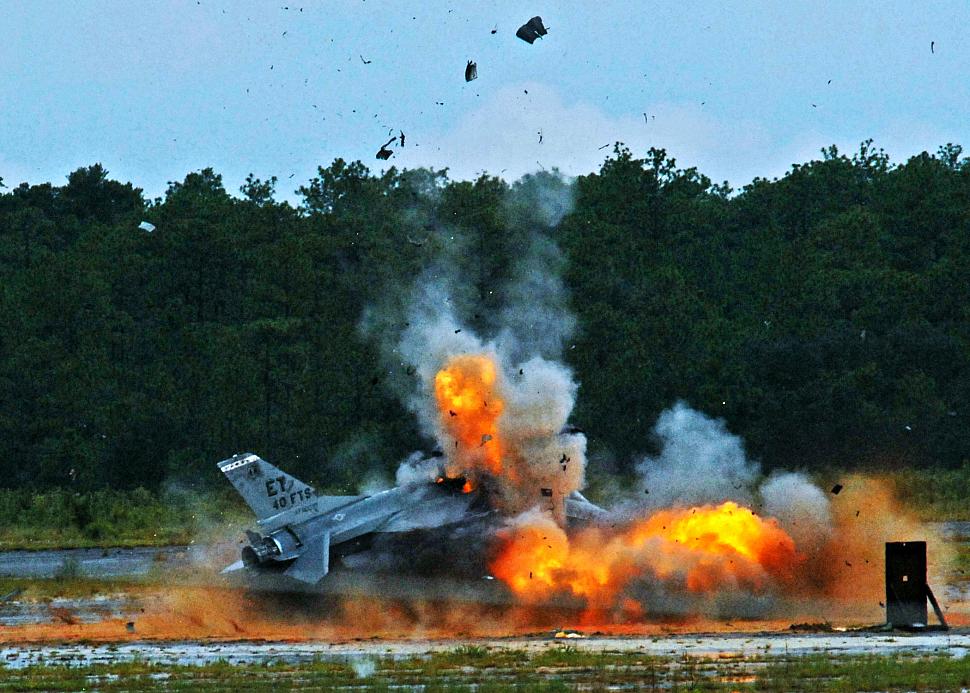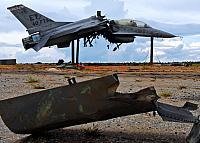Fighter Jet News
F-16 Fighting Falcon News
F-16 destruction is step toward fighter's new role
August 25, 2010 (by
Samuel King Jr.) -
An F-16 Fighting Falcon was blown apart on the range, near Eglin on August 19th.

The explosion wasn't due to a crash or accident, but intentionally initiated to test an aerial-target flight termination system. The test was conducted by the 780th Test Squadron and overseen by the QF-16 special program office.
The purpose was to demonstrate that the FTS design will be sufficient to immediately terminate the flight of a QF-16, as well as determine a range safety debris footprint, according to Kevin Diggs, QF-16 test and evaluation lead.
The QF-16 is a supersonic reusable full-scale aerial target drone modified from an F-16. The QF-16 will provide a 4th generation full-scale aerial target for air-to-air and surface-to-air weapons system evaluation, conducted by the 53rd Weapons Evaluation Group at Tyndall AFB, Fla. At this time, the WEG uses QF-4s to conduct their full-scale aerial target missions. Each drone contains a FTS needed to satisfy range safety requirements for use in unmanned missions. The test was a milestone in the development to prepare the F-16 for its new QF-16 mission.
"We're taking these non-operational aircraft and reusing them, recycling if you will," said Mr. Diggs. "We find a better purpose for them in making them flight worthy, which gives our weapons designers the opportunity to test our advanced weapons against a modern aircraft. Additionally, our warfighters get an opportunity to train against a quality fourth generation fighter."
The non-operational F-16 from the 40th Flight Test Squadron, tail-numbered #78-0097, gave its life for the test.
At approximately 11:15 a.m., with a captive audience looking on, the range officials exploded the aircraft.
A small ball of flame burst from the middle of the aircraft, followed by thick black smoke, but no sound. The sound caught up soon after with a deep reverberating boom.
No one could see the extent of the damage at first due to the amount of smoke billowing from the wreck, but once it cleared, it revealed the F-16 had been split in half between the cockpit and the wings.
"It's sad to see an F-16 destroyed like this," said Maj. Wayne Chitmon, 82nd Aerial Targets Squadron, the squadron that will eventually own and operate the QF-16s. "At the same time, however, it's exciting to know the fourth generation ability of the F-16 will enhance the warfighters' capabilities."
After the range was cleared, the test team began inspecting the wreckage and collecting data. In the coming weeks, test reports will explain the outcome and success of the test.
The next step for the program office is to evaluate those reports from the 780th and Boeing (the QF-16's prime contractor.) The project will then move forward to certifying the QF-16 with Air Armament Center range safety for unmanned flights in the future.
"This test was one step toward satisfying range safety requirements," said Mr. Diggs.
The first production QF-16 is scheduled to be delivered in 2014. The QF-16 will replace the QF-4, the third generation full-scale aerial target.

USAF F-16B block 1 #78-0097 explodes, sending debris and shrapnel into the air on August 19th on the Eglin AFB range. The explosion was a static test of the flight termination system to be used in the QF-16. The purpose was to demonstrate that the FTS design will be sufficient to immediately terminate the flight of a QF-16 as well as determine a range safety debris footprint. [USAF photo by Samuel King Jr.]
The purpose was to demonstrate that the FTS design will be sufficient to immediately terminate the flight of a QF-16, as well as determine a range safety debris footprint, according to Kevin Diggs, QF-16 test and evaluation lead.
The QF-16 is a supersonic reusable full-scale aerial target drone modified from an F-16. The QF-16 will provide a 4th generation full-scale aerial target for air-to-air and surface-to-air weapons system evaluation, conducted by the 53rd Weapons Evaluation Group at Tyndall AFB, Fla. At this time, the WEG uses QF-4s to conduct their full-scale aerial target missions. Each drone contains a FTS needed to satisfy range safety requirements for use in unmanned missions. The test was a milestone in the development to prepare the F-16 for its new QF-16 mission.
"We're taking these non-operational aircraft and reusing them, recycling if you will," said Mr. Diggs. "We find a better purpose for them in making them flight worthy, which gives our weapons designers the opportunity to test our advanced weapons against a modern aircraft. Additionally, our warfighters get an opportunity to train against a quality fourth generation fighter."
The non-operational F-16 from the 40th Flight Test Squadron, tail-numbered #78-0097, gave its life for the test.
At approximately 11:15 a.m., with a captive audience looking on, the range officials exploded the aircraft.
A small ball of flame burst from the middle of the aircraft, followed by thick black smoke, but no sound. The sound caught up soon after with a deep reverberating boom.
No one could see the extent of the damage at first due to the amount of smoke billowing from the wreck, but once it cleared, it revealed the F-16 had been split in half between the cockpit and the wings.
"It's sad to see an F-16 destroyed like this," said Maj. Wayne Chitmon, 82nd Aerial Targets Squadron, the squadron that will eventually own and operate the QF-16s. "At the same time, however, it's exciting to know the fourth generation ability of the F-16 will enhance the warfighters' capabilities."
After the range was cleared, the test team began inspecting the wreckage and collecting data. In the coming weeks, test reports will explain the outcome and success of the test.
The next step for the program office is to evaluate those reports from the 780th and Boeing (the QF-16's prime contractor.) The project will then move forward to certifying the QF-16 with Air Armament Center range safety for unmanned flights in the future.
"This test was one step toward satisfying range safety requirements," said Mr. Diggs.
The first production QF-16 is scheduled to be delivered in 2014. The QF-16 will replace the QF-4, the third generation full-scale aerial target.
Courtesy of Team Eglin Public Affairs
Additional images:


An explosion ripped the F-16B block 1 #78-0097 into two pieces and scattered debris across the Eglin AFB range on August 19th. The explosion was a test of the flight termination system to be used in the QF-16. The purpose was to demonstrate that the FTS design will be sufficient to immediately terminate the flight of a QF-16 as well as determine a range safety debris footprint. [USAF photo by Samuel King Jr.]
Related articles:
Forum discussion:
Tags
- Boeing receives phase 1 contract for QF-16 Drone (2010-03-09)
- Boeing receives 1st F-16 for conversion to QF-16 Aerial Drone (2010-05-27)
- F-16 Fighting Falcon news archive
Forum discussion:
- QF-16 destruct test; w/o F-16B 80097 ( 26 replies)
Tags
